Behind the Scenes of Designing Jumpstart
Jumpstart is a way to play Magic that's meant to put the emphasis on fun and variety rather than on tedious decision-making. But it takes non-casual effort to create casual gameplay. You want to create a format that's breezy and lighthearted and quick to play? Get ready for years of rigorous design work! Today, we're taking a look at some of the heavy design work that went into keeping Jumpstart light.
The Pitch: Why am I not already playing Magic?
Jumpstart began, appropriately enough, as a five-minute presentation. Back in 2017, there was a round of short presentations to pitch new product ideas to R&D leadership. My main job for Magic is on the Worldbuilding team, but I love straddling that line between creative and design, so I gave a quick presentation for this quick format.
"For many players, there's too many decisions in Booster Draft!" I pitched, gesticulating in front of some PowerPoint slides. "A lot of players just want to pick a direction, get playing, and see what happens!" I didn't know if the idea could really turn into something, but sometimes you just pitch with confidence and hope, you know? "There should be an alternative way to play that lets you make a small number of fun decisions but does the rest of the deck building for you!"
My pitch revolved around the rallying cry of "fewer decisions," but that can be a tough sell inside Magic R&D. We love decisions. We'll spend hours trying to decide on proper odds for a fight between Muhammad Ali and Yoda, or whether gum is food. We build products and formats that start with the dozens of decisions inherent in Booster Draft and add even more layers of decisions on top.
And those formats are awesome. I love Conspiracy and 2HG Draft and Rotisserie Draft. But gaming time is not always Crunchy Decisions Time. Sometimes you just want to Jumpstart.
Anatomy of a Jumpstart Booster
The idea was for a format where you'd shuffle together themed packs. Jumpstart boosters are like miniature 20-card theme decks—each one has a flavorful theme and a mechanical heart, built to contain everything you need to play. The delight comes in when you jam two of these packs together, getting a hilarious mongrel of two themes that has everything you need to play. Each Jumpstart booster has lands and creatures, ways to interact with your opponent, powerhouse cards to help you close out the game, and a sensible mana curve—so any combination of two packs is a ready-to-play complete Magic deck, plus a free identity crisis!
Let's take a look at one Jumpstart pack you might open. This one is called Predatory, a green pack themed around hunting and consuming your prey.
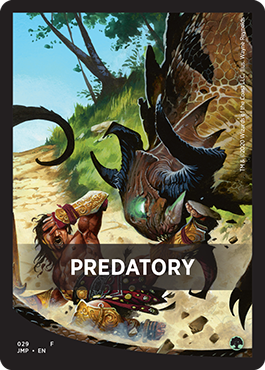
This is the theme card that tells you a bit about the pack. Every Jumpstart pack has one of these theme cards to tell you the color of the pack and to give you a hint about what that pack's about.
- 6 Forest
- "Predatory" Forest
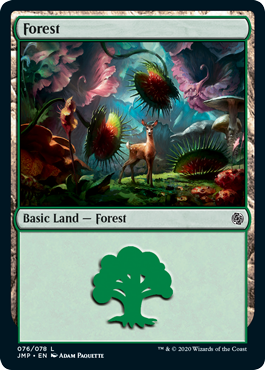
Besides the usual basic lands, every Jumpstart pack comes with a land with specially created art that's themed to the pack it's in. This is the Predatory forest, themed to the pack's prey-hungry nature. You're in danger of getting munched, little deer!
- Thriving Grove
This is another green-producing land, but with a twist. More on the Thriving lands soon!
Next are some delicious creatures. These are your prey, critters that give benefits when you gobble them up. Jumpstart packs are designed to have good cheap creatures to help get you onto the board quickly.
- Gingerbrute
- Dawntreader Elk
- Brindle Shoat
- Trufflesnout
Then, there are ways to hunt. These are your creatures and spells in the pack that deliver the flavor of predation but also work well with the pack's delicious prey. We made sure that Jumpstart packs also have ways to gain a big advantage and end the game. It was truly fun calling on Magic's deep history to find cards that both satisfied the mechanical needs and fit the pack's theme.
- Affectionate Indrik
- Sabertooth Mauler
- Fungal Rebirth
- Irresistible Prey
- Time to Feed
And then there's some assorted utility to keep you attacking and out of sticky situations. The spirit of the format is to shuffle up and play, so Jumpstart packs are designed to come pre-equipped to deal with tricky permanents and weird situations.
And then there's this pack's special rare. In many cases, we designed new cards to really nail the theme of the pack. Meet Neyith of the Dire Hunt! Look out, prey species!
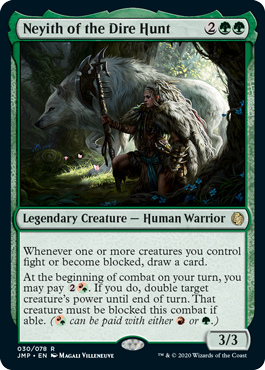
For many of the new legendaries in Jumpstart, you'll notice a hybrid symbol in its text box. It's designed to open up new space to create a new two-color Commander deck, all while letting you activate the ability even if your Jumpstart deck doesn't support that second color.
Note that many Jumpstart themes have variant decklists. We wanted to keep the experience fresh even after you've played a bit of Jumpstart. So, while some themes (like "Teferi," which we'll see later) always have the same decklist, others (like "Dragons") have two different variants with some slightly different thematic cards. And some themes (like "Predatory" here) appear in four different versions! The variant decklists may have different rares, and perhaps slightly different removal spells or creatures—some even have more than one rare! But the variant decklists of a given theme always have the same general flavor, mana curve, and game plan. Even if your opponent can tell you have the Goblins theme in your deck, they won't be sure exactly which Goblin-y cards you might be sporting—but they'll know you're probably going to make lots of Goblins and attack.
Here are the four Predatory decklists.
NOTE: Decklists automatically pull the most recently printed card images from Gatherer. The card images you see here will differ from the received product depending on when you last visited this page, including any special frame treatments which aren't already in Jumpstart. Once Jumpstarthas been added to Gatherer, you can view the exact printings there.
Now, let's jump back to the story of Jumpstart's creation.
The Hackathon: One week to find the fun
The initial pitch to my bosses went well enough that I was invited to lead a team during the first "R&D Hackathon." Along with several other Hackathon teams, we got our schedules cleared for an intensive week of brainstorming and exploration devoted to a single project. I got to work on Jumpstart with the powerhouse team of Aaron Forsythe, Annie Sardelis, and Jess Lanzillo.
The goal of that Hackathon week wasn't really to figure out every detail of the design—that would come later. The Hackathon was for trying a lot of things rapidly and finding what was fun. We asked ourselves a lot of questions and tried lots of answers. What should the structure of a booster be? How many cards per pack? What should the mana look like? How many themes should be multicolor versus monocolor? Do you open the packs and jam them together, or do you draft them to try to get the themes or colors you want? How many total themes should there be to maintain a sense of surprise and replayability? How much of the pack should be creatures versus spells? What kind of mana fixing should there be?
And of course, what should the individual themes be?
As is usually the best path, we built a bunch of test packs and tried a bunch of stuff. We built themes like "Goblins" and "Spooky" and "Under the Sea" and jammed them together in different combinations, then we compared notes. We got our colleagues to volunteer to playtest and got feedback, and we built new packs and tweaked the previous ones. The beauty of the Hackathon is that your only priority is that one project, and you're free to zigzag around in the design space as much as you need to—we often tried out a new model in the morning, then threw it out, redesigned a bunch of stuff, and printed out a new prototype the same afternoon. We quickly found that a nugget of fun was there—the packs were generally functioning as miniature decks, weird and hilarious theme combinations were happening, and players were laughing! But we also found a lot of pitfalls—issues we'd have to fix if Jumpstart were to become a real product.
Vision Design: Easier play means harder design
Jumpstart got the go-ahead to proceed to the Vision Design team to begin sculpting the project into a real product. I got to work with incredible designers Sam Stoddard, Yoni Skolnik, Mark Gottlieb, Ethan Fleischer, Ari Nieh, and Annie Sardelis, and we got the help of Mark Heggen from the Product Strategy team to help us figure out how to actually manufacture this weird thing.
During the months and years we worked on Jumpstart, we kept running into this principle over and over—that if you want to ease the load on the player, you have to put that load on the design work. We wanted Jumpstart to generate new decks effortlessly but also lead to Magic games that were as fun and satisfying as possible. We stubbed our toes against several design issues along the way but did the work to fix them.
One big issue we faced was how to combine Jumpstart packs. After testing many methods of building decks, we settled on two main methods: Two-Pack Jumpstart and Four-Pack Jumpstart. In Two-Pack, you just open two packs and shuffle them together, and you're ready to play. That's the absolute simplest way to play Jumpstart. No agonizing over your twenty-third card or whether to run that off-color cycling land—just fire it up.
Four-Pack Jumpstart, though, is my favorite way to play. It's still super quick, but it gives you a bit more ability to choose how your themes combine. It really showcases the fun of the possible combinations and the oddball variety of Jumpstart.
During vision design, we also tried drafting Jumpstart packs. The inner clear packaging lets you unwrap boosters and draft entire packs just based on their themes. Try booster drafting Jumpstart: Everybody opens three Jumpstart packs. Draft one of the packs (we did this by just looking at the theme card, not by looking through the whole decklists, but you do you), and pass two packs to your left. Then draft one and pass one. Once you've passed your last pack, you've now drafted three packs. Choose your favorite two and combine them to form your Jumpstart Draft deck (or go hog wild and shuffle all three together into a 60-card monstrosity). Let me know @omnidoug if you come up with other Draft variants!
Another design challenge we faced was the mana. We knew we wanted lands included in Jumpstart packs so that you didn't have to fiddle with figuring out your mana—we wanted you to be able to just grab a couple of packs and play. But we wanted a bit more mana fixing so you could hit double-mana costs and your two colors easily. And that need created interesting design wrinkles of its own.
Since each pack can potentially combine with any other pack, traditional dual lands (e.g. Meandering River) wouldn't generally be very helpful. So, we created a new cycle of lands engineered to meet the specific needs of Jumpstart players. Introducing the Thriving lands!
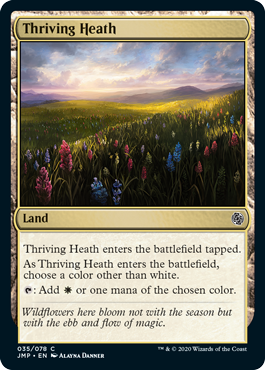
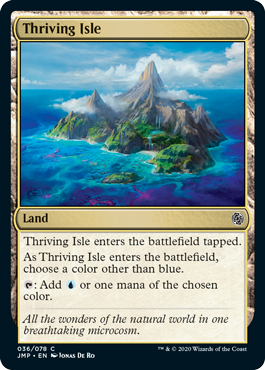
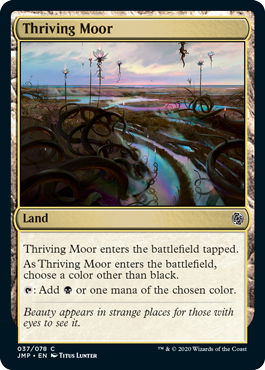
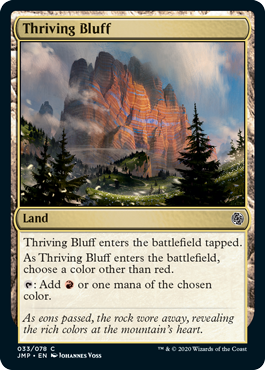
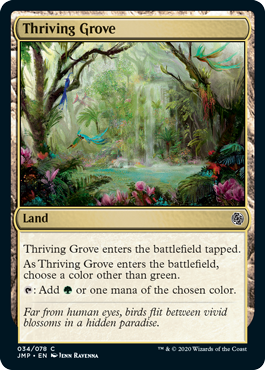
Each Jumpstart pack comes with one of these lands to help you access your mana. They sort of instantly become the correct Gate for your deck's colors. Maybe you have other uses for them outside of Jumpstart too!
The rest of vision design was spent filling out Jumpstart with themes, fiddling with decklists, and lots of playtesting. Once we had a prototype that was working well (and by "prototype" I mean "a bunch of rubber-banded packets of cards with hand-drawn theme cards that I hauled to all of our meetings"), we moved on to the final stage of development.
Set Design: Fine-tuning the details
Our Set Design team included (at various times) Yoni Skolnik, Adam Prosak, Jadine Klomparens, Reggie Valk, Ari Nieh, and Michael Hinderaker. I want to call out Yoni Skolnik's work in particular. He wasn't just my strong second and an even-handed expert designer through both vision and set design—he was also an all-around process wizard. For example, our usual card database didn't have a way to store Jumpstart decklists for us to work on and refine, so Yoni designed a data storage system to keep track of all the different Jumpstart themes and their variants, which we ended up using throughout the set design process. Lifesaver. Thanks, Yoni!
The bulk of set design was spent on fine-tuning decklists and tweaking our new Jumpstart cards to be as cool as possible. One tricky challenge was to maintain a sense of accurate rarity for the cards that would be debuting in Jumpstart, like Neyith of the Dire Hunt. We constructed a scheme to make sure that each new card would show up with about the right frequency by including it in the right number of Jumpstart boosters. That was easy enough for rares, but it led to some wild challenges when some pack themes needed a new common. That led to cards like Lightning Visionary, which in order to show up in the right number of pack themes, had to be able to make flavor sense in the Minotaurs pack, the Spellcasting pack, and the Lightning pack! Nice work, Lightning Visionary.
We knew Jumpstart would overlap heavily with Core Set 2021, so during set design, we worked closely with M21's lead designer Adam Prosak to take inspiration from the set themes his team was already cooking up. Core Set 2021 and Jumpstart both faced challenges because of some of their cards overlapping, but that also allowed for some powerful opportunities. The Core Set 2021 team helped us out in many cases by designing new cards that Jumpstart could use in its theme packs, such as Trufflesnout and Sabertooth Mauler in the "Predatory" theme. We labeled and tagged cards in the database so everyone was aware of what cards would impact which Jumpstart themes. If any card changed in Core Set 2021, it could potentially alter the mana curve or mechanical identity of multiple Jumpstart packs. That was challenging to say the least, and I'm glad we had such great partners in Adam and his team.
One of Core Set 2021's cool features is a vertical cycle of cards themed to its five Planeswalkers (the non-Ugin ones). That let us create some sweet Jumpstart packs that bring together all those themed cards for a heavily character-focused pack. "Yeah, but a vertical cycle is a common, an uncommon, a rare, and a mythic rare," you might point out. "If all of those went into one pack, then those packs would get two rares." Yep, that's what it meant. So, some Jumpstart packs just have more than one rare in them. It made sense for the Planeswalker-themed packs, and it made sense for some others as well.
Let's take a look at one of those now: the Teferi booster. It's a pack that really enjoys drawing from its library and casting its spells, just like Teferi himself.
NOTE: Decklists automatically pull the most recently printed card images from Gatherer. The card images you see here will differ from the received product depending on when you last visited this page, including any special frame treatments which aren't already in Jumpstart. Once Jumpstart has been added to Gatherer, you can view the exact printings there.The themed land for each of those five Planeswalker-themed Jumpstart packs is the showcase basic land themed to that character. So fancy!
We also spent a hilarious amount of time thinking about the names of the Jumpstart themes. I am not sure if that counts as game design, but we thought about it a lot. Initially, not all the themes' placeholder names were that great at combining. But we had such fun calling our decks "Doctor Garruk" or "Spooky Archaeology" or "Dinosaurs Above the Clouds" that we took several passes to create as much easily combinatoric nomenclature as possible. Please, PLEASE tweet at me @omnidoug with any good name combos you come up with. For science!
Dozens of playtests and rounds of tweaking the decklists later, Jumpstart was complete. It ended up being what I hoped way back at the pitch stage: a lighthearted, informal-feeling, low-stress deck-building experience that nevertheless generates many hours of cool Magic gameplay. Whether you're just getting into Magic or you've been conquering queues for years, I think Jumpstart will put a smile on your face. I hope you'll give it a try.

